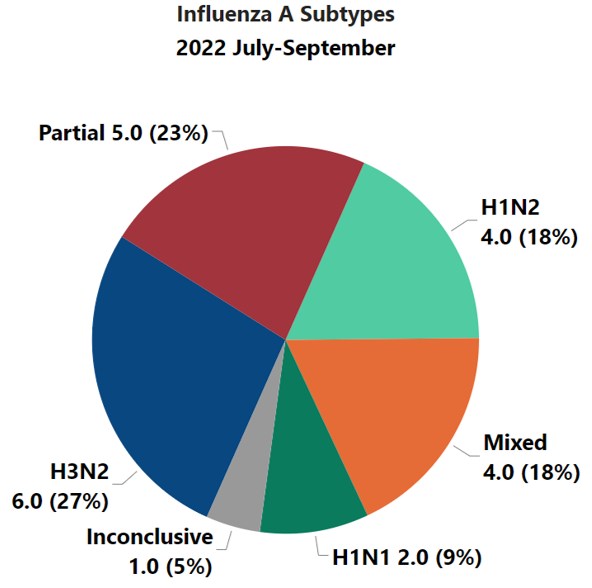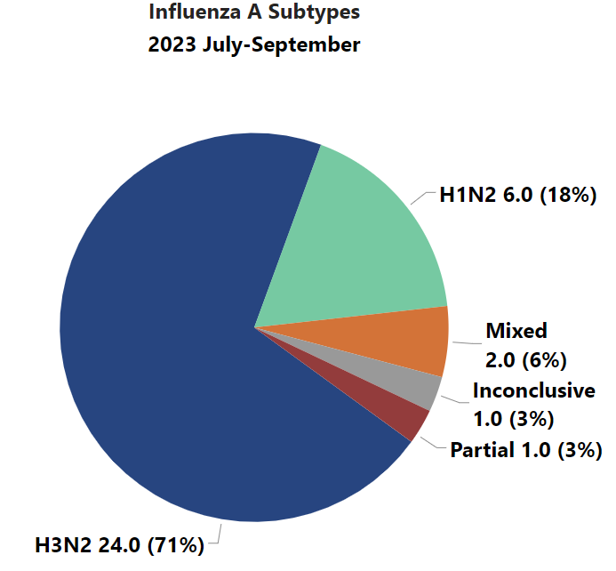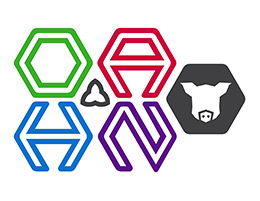Swine Industry Report – Q3 2023
Ontario Animal Health Network (OAHN) Swine Network Quarterly Producer Report
Novel Influenza A- H3N2 Cluster 2010.1
Dr. Hannah Golightly from OMAFRA provided an overview on Influenza A in swine submissions that were received during Q3 at the Animal Health Lab (AHL). In contrast to Q3 2022 (chart a, below), that majority of Influenza subtypes isolated in Q3 2023 were H3N2 (chart b, below), reflecting the dominance of a novel H3N2 cluster known as 2010.1, which has been circulating in Ontario swine herds since April 2023. At the Ontario Association of Swine Veterinarians (OASV) fall conference, Dr. Kevin Vilaca from South West Ontario Veterinary Services shared that this novel H3N2 strain has been added to a separate autogenous vaccine for producers. We encourage producers to talk to your veterinarian about the potential use of an influenza autogenous vaccine in your herd. The future plan is to include this novel influenza strain with the regional swine Influenza vaccine (contains multiple strains of influenza virus) after the CFIA approves in Jan 2024.


Porcine Epidemic Diarrhea (PEDV)/ Porcine Deltacoronavirus (PDCoV)
Jessica Fox, Manger at Swine Health Ontario (SHO) reported that there has been a slight decrease in incidence of both PED and PDCoV since the beginning of Q3. There were 10 cases reported in Q3 2023:
County Name: Bruce (1), Grey (1), Oxford (2), Perth (3), Huron (1), Waterloo (2)
Disease Type: PED (9) PDCoV (1)
Farm Type: Finisher (10)
Jessica also reported that there have been no additional cases in Q4 2023 thus far with no new cases reported since August 31 2023. All cases are pursuing elimination.
The PED and PDCoV Tracking map is available at the Swine Health Ontario website and shows current and annual cases by county. http://www.swinehealthontario.ca/Disease-Information/PED-PDCoV-Tracking-Map
OAHN Project Update: Producer Impression Survey on Health-Related Issues
Dr. Tim Blackwell reported on an OAHN project that examined Ontario pork producers’ impressions of health-related issues on their farms. The goal was to see if there were notable differences between what the producers identified as health-related issues and the health-related issues reported by veterinarians that participate in the OAHN Veterinary Clinical Impressions survey. There were 80 producers that responded to the survey on an anonymous basis.
The responses were reported for all respondents as a whole and then responses were analyzed by production categories as indicated in a very simple demographic question based on production type. Veterinarians commonly report health problems related to PRRS and Influenza as major health concerns on farms. Although producers included PRRS and Influenza in their top health-related issues there were some issues such as lameness or postweaning scour that had higher responses as top health issues.
The survey asked “Who do you initially ask for advice on a health-related Issue”? The veterinarian was listed 57% of the time. Dr. Blackwell wanted to emphasize that the internet did not rank very highly on this question.
Take Home Messages: The OAHN Swine Network would like to thank the producers that took the time to participate in this project and to fill out this survey. Veterinarians were encouraged to include producers top rated health issues listed above in their herd health visits and ensure that information is provided to producers on these topics.
International Disease Topics Of Interest Summary
Does Manure Pumping Affect the Incidence of Disease in Pigs?
Researchers at Iowa State, with funding from the Swine Health Information Center (SHIC), the Foundation for Food and Agriculture Research and Pork Checkoff, have been studying the effect of manure pumping on the disease incidence in pigs. Besides studying the disease incidence, the researchers will look at the detection of PRRSV and PEDV in pigs and environmental surfaces before and after manure spreading in wean to-finish barns. The study is in the preliminary phase. It took place from August 2020 and December 2022. The study looked at the mortality in the two-week period after pumping manure compared to the mortality before the pumping event. Other manure pumping practices such as tank or drag hose, direct injection or airway and deep pit or lagoon were collected.
The preliminary analysis of 3,000 events over 594 sites and 1,358 groups found that mortality was 21.3% lower in the two weeks after pumping in sites that transported manure in tanks than sites that used drag lines. There was no difference in mortality in sites that used direct injection or airway and sites that had deep pits or lagoons. The researchers concluded that with tanks the farther away from the pump site the manure is applied the lower the mortality. The next part of the study will be modeling that includes sites with and without disease onset and with or without exposure to pumping. (AASV News Archive, 9/14/23)
Illegally imported pork recalled in U.S.
The UDSA’s Food Safety and Inspection Service, FSIS, found illegally imported pork during a routine inspection of a retail store. The products were ready-to-eat pork chicharrónes. The products were imported from Honduras. There are restrictions on the export of pork from Honduras to the U.S. because of the risk of Classical Swine Fever (CSF). The product did not bear a USDA mark of inspection. The products were imported into Georgia, Louisiana, Mississippi and Texas. A recall was issued, and the FSIS will conduct a recall effectiveness audit. (National Hog Farmer,9/27/23).
Take Home Message: This research article emphasizes how easily African Swine Fever or Classical Swine Fever could be brought into Canada through pork products. Therefore, it is important that producers remember that biosecurity on and off your farm is the most important line of defense. Review biosecurity protocols, including ensuring no pork products are allowed in the barn, with your family members and with staff.


